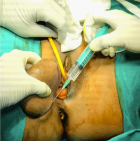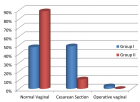Table of Contents
Branchio Oculo Facial Syndrome
Published on: 29th November, 2019
OCLC Number/Unique Identifier: 8508295972
A 3-month-old girl presented to the surgical consultation room with bilateral cleft lip incomplete. A girl weighing 4205 g, was born at term after an uneventful pregnancy with a birth weight of 2500 g. There was no family history. On examination, a congenital, linear, erythematous cutaneous anomaly on the left side of her neck was highlighted with ocular anomalies (strabismus and the eyes are widely spaced) and a broad nose with a flattened tip. The examination of the other systems was unremarkable. In front of the association of these different anomalies BOFS was suspected but molecular diagnosis has not been made. The child benefited surgery to correct cleft lip with tennisson procedure with a good postoperative result.
Glycemic status and its effect in Neonatal Sepsis - A prospective study in a Tertiary Care Hospital in Nepal
Published on: 27th September, 2019
OCLC Number/Unique Identifier: 8278647740
Introduction: Sepsis is an important cause of morbidity and mortality among neonates. Neonatal sepsis can alter the glucose level and both hypoglycemia and hyperglycemia may occur. A high or low blood glucose level may have a significant effect on the outcomes in patients of neonatal sepsis.
Aims: The aim of the study to see the glycaemic status and its effect on outcome of neonatal sepsis.
Material and Methods: This hospital based prospective observational cross-sectional study was conducted in Neonatal Intensive Care Unit in Universal College of Medical Sciences, a tertiary care hospital over a period of 4 months, from May 2019 to August 2019. A total of 220 Neonates suspected sepsis under the age of 28 days admitted in NICU, were studied and included in our study. Clinically suspected neonatal sepsis cases were enrolled in the study. Venous blood was collected before giving any intravenous fluid, dextrose or antibiotics and blood sugar, complete blood counts, CRP levels and blood culture were send to laboratory within half hour of collection. All patients included in this study were treated accordingly and followed up strictly. Blood glucose level and mortality of neonates having hypoglycemia, hyperglycemia were analyzed among CRP and culture positive patients. Quantitative data were expressed as mean and standard deviation. Qualitative data were expressed as frequency and percentage and comparison carried by Chi-square (χ2) test.
Results: A total of 220 patients clinically diagnosed as neonatal sepsis were studied. 118 (53.6%) patients were found CRP positive and 56 (25.5%) patients were blood culture positive. Glycaemic status was analyzed among CRP and culture positive patients. Majority (55.9%) patients were found normoglycemic, 35.5% were found hypoglycemic and 8.6% were found hyperglycaemic in this study. 182 (82.73%) patients were cured and 38 (17.27%) died. Mortality was high in hypoglycaemic patients (34.4%) compared with normoglycaemic patients (9.82%), but the difference was not statistically significant (p > 0.05) between two groups, the mortality was high in hyperglycaemic patients (58.33%) compared with normoglycaemic patients (9.82%) and the difference was statistically significant (p < 0.05) between two groups.
Conclusion: Alteration of glycaemic status occurred in septic newborn. Mortality is higher among the septic newborn with hyperglycemia. The present study found that majority of neonate with sepsis had high mortality rate when blood glucose level were either more than 145 mg/dl or less than 45 mg/dl. This signifies the importance of meticulous blood glucose estimation in cases of neonatal sepsis to improve mortality outcome.
Does it matter what a mother consumes? An anthropological exploration of dietary practices among Churachandpur (Manipur) pregnant women and its impact on infant birth weight
Published on: 2nd September, 2019
OCLC Number/Unique Identifier: v
Background: Nutritional status of expectant women is an important indicator of healthy pregnancy and an ideal birth weight of the infant. The present study is an attempt to understand food eating practices and related taboos among the Paite women and whether or how these practices influence weight gain among infants during their first year of life.
Methods: The longitudinal study was conducted for a period of 16 months between November 2010 and February 2012) among 186 Paite mother-infant pairs. Women who had completed 37 to 42 weeks of pregnancy were included. Infant’s weights were measured using standard technique and information on mothers’ food related practices was recorded during the house visit using a structured schedule. Standard statistical methods were used for description and analysis.
Results: A peculiar practice, ‘pica’ was observed among a few women. A number of food taboos were found to be followed by the ‘Paite’ women during course of their pregnancy.
Conclusion: No significant difference was noticed in the mean weight of babies from birth through the age of 1 year between mothers practicing and not practicing food taboos. However, it was found that the mean weight of the babies throughout the study period was comparatively higher among non-taboo mothers. It could be suggested that women must be counseled during their antenatal and postnatal visits to the maternity clinics and hospitals about dietary practices and their anticipated impact on health of the newborns.
Prevalence of ESBL urinary tract infection in children
Published on: 8th August, 2019
OCLC Number/Unique Identifier: 8207299945
Urinary tract infection (UTI) is one of the extremely popular causes of febrile illness in children, demanding antimicrobial therapy [1]. Overall, 8% of females and 2% of males, experience at least one incident of UTI by seven years of age, and recurrence takes place in up to 30% during a year [2].
Severe Infantile Transaldolase deficiency: A case report
Published on: 24th July, 2019
OCLC Number/Unique Identifier: 8207287340
Transaldolase TALDO deficiency is a rare autosomal recessive disorder of the pentose phosphate pathway. It has variable presentations with poor outcome when present early in life. We present a young Saudi infant with a fatal early presentation of TALD deficiency.

If you are already a member of our network and need to keep track of any developments regarding a question you have already submitted, click "take me to my Query."



















































































































































